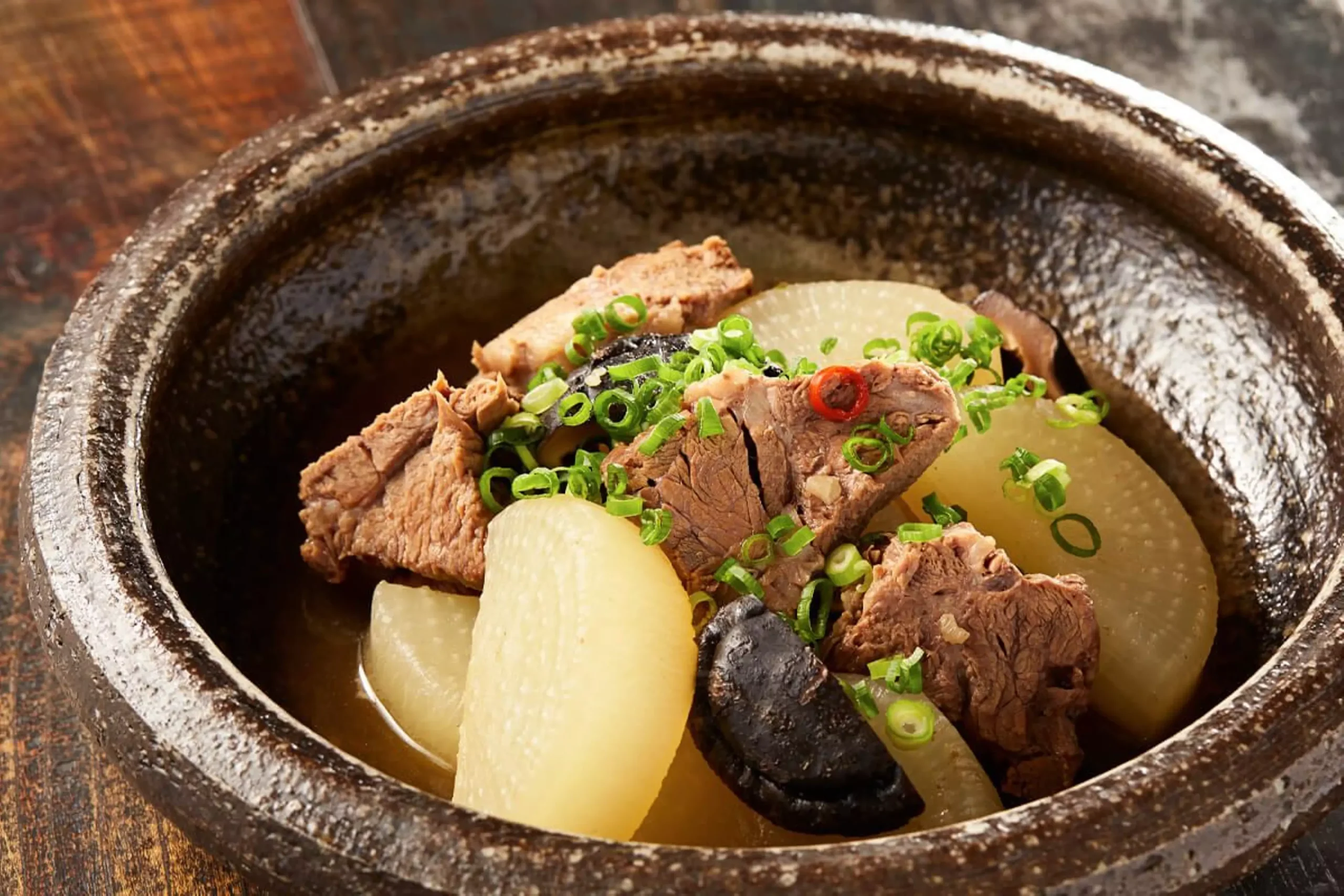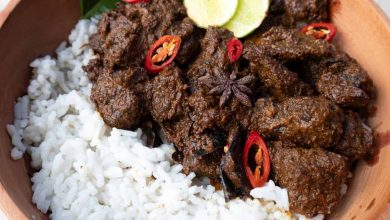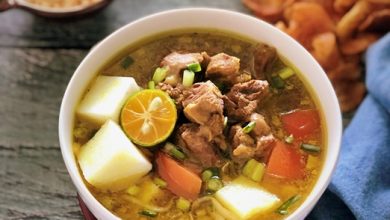Indulge in the harmonious blend of savory, sweet, and umami flavors with our Japanese-Style Beef and Daikon Stew, known locally as Semur Lobak Sapi ala Jepang. This comforting dish features tender slices of beef and subtly sweet daikon radish simmered in a rich, flavorful sauce. Perfect for a cozy family dinner or an elegant meal for special occasions, this stew brings together the best of Japanese culinary techniques with the hearty essence of traditional stews.
Table of Contents
- Introduction
- Time
- Needed Equipments
- Tags
- Serving Size
- Difficulty Level
- Allergen Information
- Dietary Preference
- Course
- Cuisine
- Ingredients
- Instructions
- Preparation Tips
- Nutritional Information
- Tips and Tricks
- Add-ons
- Side Dishes
- Improvements
- Save and Store
- FAQ
- Conclusion
- References
Time
- Preparation Time: 20 minutes
- Cooking Time: 35 minutes
- Total Time: 55 minutes
Needed Equipments
- Large Pot or Dutch Oven: For simmering the stew.
- Large Skillet or Saucepan: For sautéing aromatics and browning beef.
- Cutting Board and Sharp Knife: Essential for slicing beef and daikon.
- Measuring Spoons and Cups: To ensure accurate ingredient proportions.
- Minced Garlic Tool: Optional, for easier garlic preparation.
- Blanching Pot: A separate pot for blanching daikon radish.
- Serving Bowls: To present the finished stew.
- Chopping Tools: Such as a vegetable peeler and onion chopper.
Tags
- Main Ingredients: Beef, Daikon Radish
- Cuisine: Japanese, Indonesian
- Meal Type: Dinner, Lunch
- Dietary: Gluten-Free (if shoyu is gluten-free), Can be made with low-sodium options
- Cooking Method: Simmering, Sautéing
- Special Occasion: Family Meals, Cozy Dinners
- Season: All Year Round
Serving Size
- Servings: 4
- Per Serving: Approximately 350-400 grams
Difficulty Level
- Intermediate: Requires familiarity with sautéing and simmering techniques.
Allergen Information
- Contains: Soy (from shoyu/soy sauce)
- Potential Allergens: May contain wheat if using traditional shoyu; use gluten-free soy sauce as needed.
Dietary Preference
- Adaptable For:
- Gluten-Free: Substitute shoyu with tamari.
- Low-Sodium: Use low-sodium soy sauce and beef stock.
- Dairy-Free: Naturally free of dairy.
- Halal/Kosher: Ensure beef and other ingredients meet dietary laws.
Course
- Main Course: Perfect as a hearty main dish.
Cuisine
- Fusion Cuisine: Combines elements of Japanese and Indonesian culinary traditions.
Ingredients
Main Ingredients
| Ingredient | Quantity |
|---|---|
| Beef chuck | 250 grams, sliced thinly |
| Daikon radish | 1 medium, sliced into 1 cm thick rounds |
| Garlic | 3 cloves, minced |
| Shoyu (soy sauce) | 4 tablespoons |
| Beef stock | 2 tablespoons |
| Sugar | 2 tablespoons |
| Olive oil | 1 tablespoon |
| Green onion | 1 stalk, chopped |
| Salt | To taste |
| Black pepper | To taste |
Optional Ingredients
| Ingredient | Quantity |
|---|---|
| Ginger | 1 teaspoon, minced |
| Mirin | 1 tablespoon |
| Sake | 1 tablespoon |
| Sesame seeds | For garnish |
Instructions
1. Prepare the Ingredients
- Slice the Beef:
- Place the beef chuck in the freezer for about 15 minutes to firm up, making it easier to slice thinly.
- Using a sharp knife, slice the beef thinly against the grain to ensure tenderness.
- Prepare the Daikon Radish:
- Peel the daikon radish and slice it into rounds approximately 1 cm thick.
- Optional: Cut the rounds into half-moons for easier eating.
- Mince the Garlic:
- Peel and finely mince the garlic cloves. For added depth, you can also mince fresh ginger if desired.
2. Blanch the Daikon
- Boil Water:
- Fill a pot with water and bring it to a boil over high heat.
- Blanch Daikon:
- Add the daikon radish slices to the boiling water.
- Blanch for about 5 minutes to soften slightly and reduce any bitterness.
- Drain the daikon and set aside.
3. Sauté the Aromatics
- Heat Olive Oil:
- In a large skillet or saucepan, heat 1 tablespoon of olive oil over medium heat.
- Sauté Garlic:
- Add the minced garlic (and ginger if using) to the hot oil.
- Sauté until fragrant and lightly golden, about 1-2 minutes. Be careful not to burn the garlic.
4. Cook the Beef
- Add Beef to Skillet:
- Add the sliced beef to the skillet with the sautéed garlic.
- Brown the Beef:
- Sauté the beef until it is browned on all sides and cooked through, about 5-7 minutes.
- Season with a pinch of salt and black pepper during cooking.
5. Combine and Simmer
- Add Blanched Daikon:
- Incorporate the blanched daikon radish into the skillet with the browned beef.
- Pour in Sauces and Sweeteners:
- Add 4 tablespoons of shoyu (soy sauce), 2 tablespoons of beef stock, and 2 tablespoons of sugar.
- Stir to ensure all ingredients are well combined.
- Add Water:
- Pour in enough water to just cover the beef and daikon. This should be approximately 1 cup, but adjust as needed based on the pot size.
- Bring to a Boil:
- Increase the heat to high and bring the mixture to a gentle boil.
- Reduce Heat and Simmer:
- Once boiling, reduce the heat to low to maintain a gentle simmer.
- Cover the pot partially to prevent excessive evaporation.
6. Simmer and Season
- Simmer the Stew:
- Allow the stew to simmer for 15-20 minutes. This allows the daikon to become tender and the flavors to meld together.
- Adjust Seasoning:
- Taste the broth and adjust seasoning with additional salt and pepper if necessary.
- For a sweeter profile, add more sugar. For more depth, consider adding a splash of mirin or sake.
7. Finish with Green Onions
- Add Green Onions:
- Stir in the chopped green onion just before serving to maintain its fresh, crisp texture.
8. Serve
- Garnish and Present:
- Serve the stew hot, garnished with additional green onions or a sprinkle of sesame seeds if desired.
- Accompaniments:
- Pair with steamed white rice, jasmine rice, or your favorite grain.
- Optionally, serve with a side of pickled vegetables or a simple green salad.
Preparation Tips
- Slicing Beef Thinly: Freezing the beef slightly before slicing helps achieve thin, even slices, ensuring tenderness in the final dish.
- Blanching Daikon: Blanching not only softens the daikon but also removes any pungent odors, enhancing the stew’s overall flavor.
- Garlic and Ginger: Incorporating ginger with garlic can add a subtle warmth and depth to the stew, aligning more closely with Japanese flavor profiles.
- Adjusting Sweetness: The balance of sweet and savory can be tailored to your preference. Start with the recommended sugar and adjust as needed.
Nutritional Information
Per Serving (Approx. 400 grams)
| Nutrient | Amount |
|---|---|
| Calories | 450 kcal |
| Protein | 30 g |
| Carbohydrates | 25 g |
| Fat | 25 g |
| Saturated Fat | 8 g |
| Cholesterol | 80 mg |
| Sodium | 1200 mg |
| Fiber | 3 g |
| Sugar | 12 g |
| Vitamin A | 15% DV |
| Vitamin C | 20% DV |
| Calcium | 6% DV |
| Iron | 25% DV |
Note: Nutritional values are approximate and can vary based on specific ingredients and portion sizes.
Tips and Tricks
- Beef Selection: Choose a well-marbled beef chuck for maximum flavor and tenderness. Alternative cuts like brisket or short ribs can also be used.
- Daikon Alternatives: If daikon is unavailable, other root vegetables like carrots or parsnips can be substituted, though the flavor profile will change slightly.
- Flavor Enhancements: Adding a splash of mirin or sake can introduce a subtle sweetness and depth, enhancing the umami profile.
- Consistency Control: For a thicker stew, mash some of the daikon or let the stew reduce further. For a soupier consistency, add more broth or water.
- Aromatics: Experiment with adding other aromatics like leeks or shallots for additional layers of flavor.
Add-ons
- Mushrooms: Shiitake or enoki mushrooms can add an earthy dimension.
- Tofu: Firm tofu can be added for extra protein and texture.
- Leafy Greens: Spinach or bok choy can be stirred in towards the end for added nutrition.
- Noodles: Serve over udon or soba noodles for a more substantial meal.
Side Dishes
- Steamed White Rice: A classic accompaniment that soaks up the flavorful broth.
- Japanese Pickles (Tsukemono): Adds a tangy contrast to the rich stew.
- Miso Soup: Complements the meal with a light, umami-rich starter.
- Green Salad: Fresh greens with a simple vinaigrette balance the hearty stew.
- Tempura Vegetables: Crispy tempura offers a delightful texture contrast.
Improvements
- Marinating the Beef: Marinate the beef in a mixture of soy sauce, sake, and a touch of sugar for 30 minutes before cooking to enhance flavor.
- Layered Flavors: Start by sautéing onions with the garlic and ginger for a more complex base.
- Rich Broth: Incorporate beef bone broth for a deeper, more robust flavor.
- Thickening the Stew: Add a slurry of cornstarch and water towards the end to achieve a thicker consistency if desired.
Save and Store
- Cooling: Allow the stew to cool to room temperature before storing.
- Refrigeration: Transfer the stew to an airtight container and refrigerate for up to 3 days.
- Freezing: For longer storage, freeze the stew in freezer-safe containers for up to 3 months. Thaw overnight in the refrigerator before reheating.
- Reheating: Gently reheat on the stovetop over low heat, adding a splash of water or broth if the stew has thickened too much.
FAQ
1. Can I use a different type of beef?
Absolutely! While beef chuck is ideal for its balance of flavor and tenderness, cuts like brisket or short ribs work well too. For a leaner option, sirloin can be used, though it may become tougher if overcooked.
2. Is this dish gluten-free?
Traditional shoyu contains wheat, making it unsuitable for a gluten-free diet. Substitute with tamari or a gluten-free soy sauce to make the stew gluten-free.
3. How can I make this stew spicier?
Add a teaspoon of chili flakes or a splash of chili oil during the sautéing stage for a spicy kick.
4. Can I use other vegetables instead of daikon?
Yes, vegetables like carrots, potatoes, or parsnips can be used as alternatives or in addition to daikon for varied textures and flavors.
5. How long can I store leftovers?
Leftover stew can be stored in the refrigerator for up to 3 days or frozen for up to 3 months. Ensure it is stored in airtight containers to maintain freshness.
6. Can I make this stew vegetarian?
Yes, substitute beef with firm tofu or seitan and use vegetable broth instead of beef stock. Enhance the umami with mushrooms and additional soy sauce.
7. What side dishes pair well with this stew?
Steamed white rice, Japanese pickles, miso soup, green salads, or tempura vegetables complement the rich flavors of the stew perfectly.
Conclusion
Our Japanese-Style Beef and Daikon Stew (Semur Lobak Sapi ala Jepang) is a versatile and comforting dish that brings together the best of savory and sweet flavors. Whether you’re seeking a hearty meal to warm you during chilly evenings or a sophisticated dish for entertaining guests, this stew fits the bill. Its adaptability allows for various modifications to suit dietary preferences and ingredient availability, making it a staple in any home cook’s repertoire. Serve it with steamed rice and your favorite side dishes to create a satisfying and memorable dining experience.
References
- LoveWithRecipes – Authentic Japanese Recipes
- The Art of Japanese Cooking
- Nutritional Guidelines for Balanced Meals
Note: Ensure to replace placeholder links with actual references or remove the section if not applicable.





